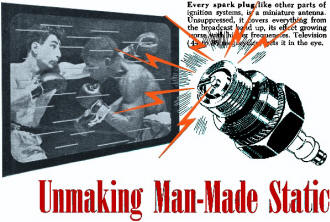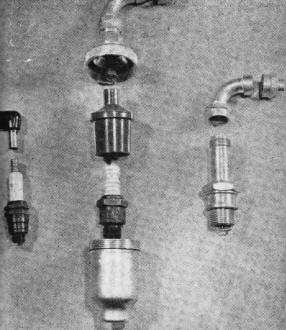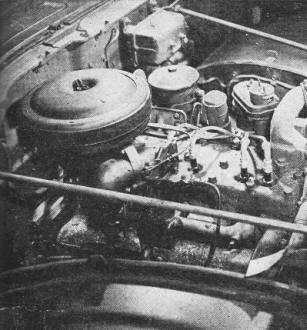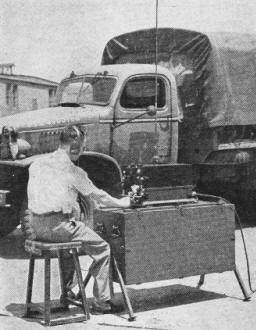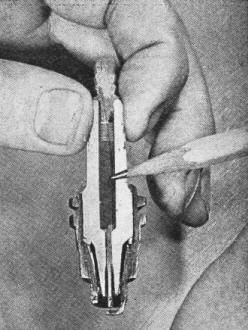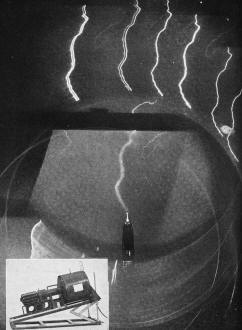Unmaking Man-Made Static
|
|||
Spark-induced interference (noise) in amplitude modulation (AM) radio has been a problem since the early days of broadcasting. Whether from a natural source (QRN in Ham lingo) like lightning or electric eel discharge (just kidding), or from multitudinous man-made sources (QRM), static manifests itself audibly as a scratching, crackling sound emanating from a speaker, headphone, or ear bud. I explain this because probably most people under twenty years old have never heard (or heard but not recognized) static in audio. Almost nobody under forty years old has ever seen the static-induced effect on video from a television screen (see photo in article). A very familiar manifestation of static noise for ICE (internal combustion engine - aka normal cars) originates in the ignition system. As its name suggests, the raison d'être of a spark plug is to generate a spark to ignite the fuel-air mixture in the cylinders. That spark's electromagnetic signature includes a broadband smear of frequencies, many of which fall within the bandwidth of a radio's circuitry, in RF, IF, and audio portions. Filtering it out once inside the radio is virtually impossible, so means are implemented to suppress it at the source. This 1948 issue of Popular Science magazine article discusses some of the early attempts at identifying and mitigating the issue. Frequency modulation (FM) radio eliminated most of the ignition noise problem, but AM can still present problems. Electric vehicles (EV's) are reigniting (pun intended) the electrical noise issue due to all the onboard DC-DC converters and computers. The EV industry's solution, if allowed to move forward, is to have auto manufacturers stop providing AM radio in cars. Unmaking Man-Made StaticEvery spark plug, like other parts of ignition systems, is a miniature antenna. Unsuppressed, it covers everything from the broadcast band up, its effect growing worse with higher frequencies. Television (44 to 88 megacycles) gets it in the eye. Ignition noise, long a radio nuisance, faces a campaign designed to knock it out of the television picture. Automobile ignition systems have been producing spluttery noises in radios since the days of crystal sets. With television, the noises turned into visible streaks and blotches - and thereby set the stage for a large-scale attack on one of radio's oldest minor headaches. The attack began during the war, when ignition interference was a major threat to vital military communications. To clear the air, a fleet of mobile Signal Corps test stations toured the country, teaching manufacturers how to build ignition systems that wouldn't sound off through near-by radios. Static is fundamentally just like any amplitude-modulated (AM) radio signal. Frequency modulation will reject it, but short of using FM for every purpose, the only way to keep interference out of a radio completely is to suppress it at the source. Eliminating ignition interference is a relatively simple operation, done quickly and easily on any car that carries its own radio. Resistors in spark-plug cables keep electro-magnetic impulses from feeding back into the wiring, which would broadcast them; metal shielding around cables and other parts helps trap other impulses, and capacitors channel them to the chassis, which is bonded into a nonbroadcasting ground.
Microsecond technique splits a lightning flash. GE's special camera (inset) shows that bolt striking Empire State Building (center of photo) is one slow discharge and six fast ones. Experts at the Coles Signal Laboratory, at Fort Monmouth, N. J., figured out scores of variations on that basic pattern. Early systems with bulky external shields barred interference only up to 40 megacycles. Research has now progressed to simpler, integrally shielded and suppressed equipment that promises interference-free communications clear up to 4,000 megacycles - and also makes ignition systems waterproof. By putting the program on a mass-production basis, military experts hurdled the biggest barrier to getting rid of ignition static - the fact that thirty-odd million U. S. cars have to be "suppressed." Now the American auto industry has taken over, and cars are being built to a set of anti-interference standards worked out by radio makers and the Society of Automotive Engineers. Accessory makers are also providing war-developed devices to help the program. As millions of prewar cars go off to junkyards, radio reception will be freed of one source of man-made static. Short-wave operators will say good-by to a lot of the "garbage" that has plagued them for years. And owners of television sets won't have to fight shy of highways or set up sky-high antennas to avoid spots before their eyes.
Posted January 3, 2024 |
|||

